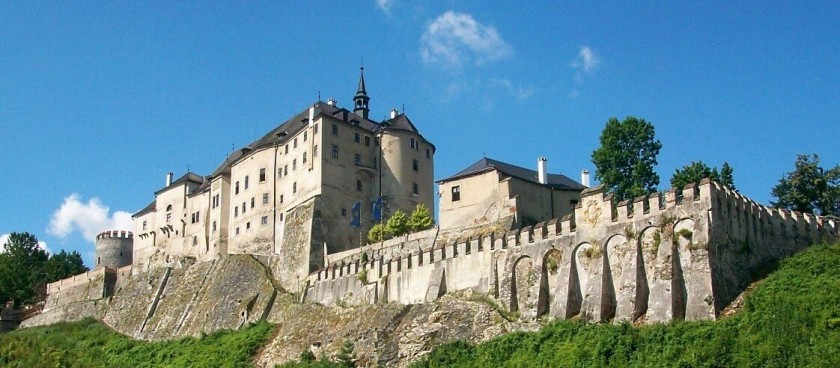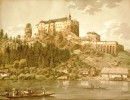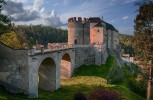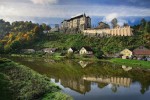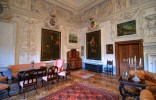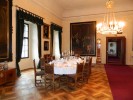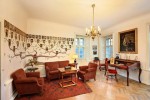- #CZ13
- Hrad Český Šternberk 257 27 Český Šternberk 1
- +420317855101
- hrad@zsternberg.cz
- http://www.hradceskysternberk.cz/
- Working hours*:
January, February, March, November, December open only for excursion groups
April, October Saturday, Sunday (9.00 - 17.00)
June, September Tuesday - Friday (9.00 - 17.00)
Saturday - Sunday (9.00 - 18.00)
July, August Tuesday - Sunday (9.00 - 18.00) - Prices*:
A ticket with an audio guide costs 180 CZK for an adult and 130 CZK for students and children.
The cost of a ticket for adults with a Russian or English-speaking guide is 230 CZK, for students and children 160. - * - opening and closing times as well as entrance prices, are subject to alterations without notice. Visitors are advised to check before visiting.
- The entrance to the castle closes 45 minutes before the end of the work.
- 49.8088821, 14.9264026 Copy to clipboard Copy
-
#Castles
Český Sternberk is a castle towering on a cliff 59 km from Prague. It is surrounded on three sides by the picturesque Sazava River. The Czech castle belongs to the category of fortified castles since it was one of the main defensive structures in the country for a long time.
The castle's name comes from the owners - Sternberk, who founded a residence here in 1241. Travel guide to this castle is often called the pearl of Middle Posazavi.
The uniqueness of the Cesky Sternberk castle in the Czech Republic lies in the fact that the same family-owned it throughout history. For 99% of buildings in Europe, the owners are constantly changing due to wars, revolutions and bankruptcy.
Interestingly, the current owner of the castle, Count Zdenek (a descendant of the Stenbergs), still lives in the court with his family. That is why the atmosphere of comfort and warmth reigns in the fortress.
I can see a photo of Sternberk castle in the list of the most popular attractions in the Czech Republic, and this place is worth a visit.
History and Present
The Český Šternberk castle was built around 1241 by Zdeslav of Divišov, who named it after his coat of arms, an eight-pointed star, calling it Sternberg (Stern = star, Berg = mountain, Šternberk is the Czech spelling) according to the custom at the time of using German names. He also adopted the new territorial surname “ze Sternberga” (“of Sternberg”).
One remarkable fact is that the castle is still owned by the same family as almost 800 years ago. The current owner is a descendant in the 20th generation of the founder.
In 1467 the castle was taken and later renovated in the late Gothic style. Improvements were made especially to the castle defences, such as a south-facing projecting bastion built “en bec” (with a sharp beak) called the Dungeon, which today serves as a look-out point. Extensive early Baroque renovations were carried out in the second half of the 1600s, when the castle no longer served its original defensive purposes and an effort was made to ensure the comfort of its inhabitants. Since that time the stone walls of this Gothic castle have been home to a chateau interior. After lifestyle changes in the early 20th c entury the castle was fitted with electricity, indoor plumbing and central heating.
We would like to invite you to take a tour of the castle, during which you can visit 15 richly appointed rooms furnished in the style of various historical periods, learn about important members of the Sternberg family and catch a glimpse of their way of life. You can also see the unique Šternberk collection of copper engravings from the Thirty Years’ War, which is one of the largest monothematic collections of engravings in Europe.
What to see in the castle
The castle has been the seat of the Sternbergs in the Czech Republic for over 800 years, so there are more interesting interior items and beautiful rooms.
The first thing that tourists see in Cesky Sternberk Castle is a spacious hall with white walls, on which there are portraits and landscapes by court painters. The floor here, like centuries ago, is made of stone, and a staircase of oak wood leads upstairs.
The ceremonial hall is the largest room in the castle. Here guests were received and held balls in the evenings.
Here is that the most expensive paintings and rare jewellery from Sternberk's collection.
There is a chandelier made of Czech crystal in the hall, which reaches 150 kg, floor with parquet with the image of eight-pointed stars - the symbol of the Sternberk's.
-
The ceremonial hall has a small room with a carved fireplace and a massive picture on the entire wall.
-
From the ceremonial hall, you can get either to the local chapel or to the living room. The chapel in the castle resembles a small one, with an altar and tapestries with images of Sternberk's coat of arms on the walls. As a rule, the owners of the castle came here for the morning and evening sacraments.
-
Received guests were in a small, richly decorated living room. There are five armchairs and one sofa on the walls for women - landscape painting and two tapestries.
-
You can access the dining room from the living room. It is quite a gloomy and darkroom because the furniture made of dark wood, heavy velvet curtains hang on the windows. The owners of the house had breakfast and dinner here. The room still used for its intended purpose.
-
The next room is the women's hall. Only ladies who wanted to rub their noses or talk in private could get through the balls here. The walls of the room painted bright red, and furniture made of walnut wood. The most important accent of the room is a large mirror with gold frames hanging between the windows.
Interestingly, all the dining chairs are of different sizes and heights: they were made for each family member because according to the rules of etiquette, all the people sitting at the table must be of the same level.
On the second floor, there are salons: golden, smoking, for women, men and knights.
-
In the smoking salon, whose walls are covered with striped wallpaper, you can see a collection of elegant pipes and many paintings. Gold salon, quite modest. Watercolor-painted walls and gold elements have only table and sofa upholstery
-
The Knights ’Hall is a place to store a collection of cold weapons and firearms and hunting trophies: antlers of deer, elk, stuffed birds and animals. On the floor lies one of the most interesting things - crocodile skin.
-
In the small room next to the Knights' Hall, you can see the Sternberg tree. Despite the rich history of the castle and family, the tree is quite small. Also, he did it relatively recently (and probably only for tourists).
-
The women’s salon is another place where women can relax during or after a party. The room has many gold details. The only harpsichord in the house stands here.
-
The men’s salon is decorated much like the women’s. There is also plenty of gold and porcelain. Portraits of ladies from the Sternberk family hang on the walls.
-
The fifth salon is a children's room in which all newborn Sternbergs lived. There is not much space here, but this is the brightest and brightest room in the castle. Decorative plates hung on the walls, and a crib and rocking pony are on the floor.
-
The last living room on the second floor is the bedroom where the owners slept. The room walls covered with burgundy wallpaper with monograms, and there is a massive oak bed in the middle. There are two small dressing tables nearby.
After visiting all the rooms of Cesky Sternberg, be sure to check out the library. The room is relatively small but very cosy and refined. More than 3,000 books (mainly fiction, scientific and literature on the history of the Czech Republic) are collected here, and an impressive view of the surroundings opens from the windows.
